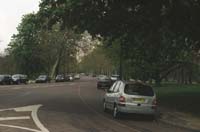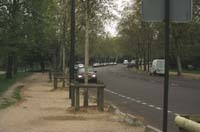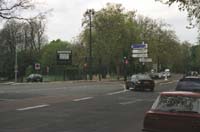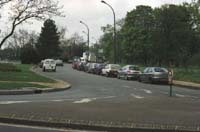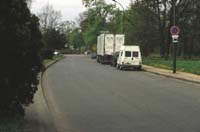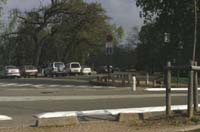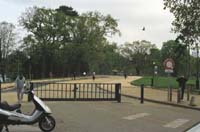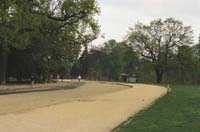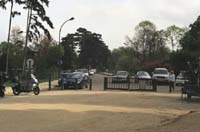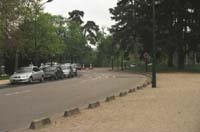The cradle of motorsport
Author
- Rémi Paolozzi
Date
- May 28, 2003
Related articles
- Maurice Trintignant - Le Petoulet's colourful career, by Mattijs Diepraam
- Jean-Pierre Wimille - The uncrowned king of the forties, by Mattijs Diepraam
Who?Jean-Pierre Wimille What?Bugatti 59/50B Where?Bois de Boulogne When?Coupe des Prisonniers (September 9, 1945) |
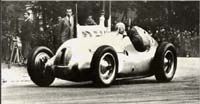 |
Why?
If you go and ask a Parisian what the Bois de Boulogne means to him, he will answer that it is a park where he often goes jogging on weekends or sometimes goes for a family picnic but where he surely never goes talking to whores in the night, what is an other story... Only a few Parisians do remember that the Bois de Boulogne was an important place in the history of motor racing: a place where it was born and even resurrected...
Some will argue that everything began on April 28th, 1887. Indeed, car manufacturers were settling in Europe and Mr Fossier, chief editor of Le Vélocipède, decided to organize a race between Neuilly Bridge and the Bois de Boulogne. It seems that this race was about 2 km long. Unfortunately the race was not a real success as there was just one entrant. Indeed, car manufacturers were not so numerous. Moreover the existing cars were not always efficient and reliable... Georges Bouton was at the wheel of the car he created with Count De Dion, the famous De Dion-Bouton. The firm had been created in 1882 and the plant was in Puteaux, very close to the start of this first race. Nowadays, if you go to Puteaux you can spend the night at the hotel De Dion-Bouton, located on the Quai De Dion-Bouton, just in front of Neuilly Bridge... Georges Bouton, the first racing driver in history, won the race as he succeeded in passing the finish line at the speed of...60km/h thanks to a power of 1hp and a 50kg-car!
Nevertheless many historians consider the Paris-Rouen race as the first true competition. It took place on July 22, 1894. The organizer was Mr Pierre Giffard, editor in chief of newspaper Le Petit Journal. It was much more a show than a real race. The regulation stipulated that, for this “competition of cars with no horse” the cars should be “not dangerous, easy to drive, and cheap during the journey”. Each competitor had to pay 10 francs at the admission. 102 cars were registered. Mr Giffard required a first 50km heat to select the cars which were able to run the 127km between Paris and Rouen. Indeed, there were real and serious manufacturers like Peugeot, Panhard or De Dion but there were also... let’s say dreamers. At last, 69 out of 102 entrants were present at the selection heat and only 25 were selected after the 50km... The start of the final race was at the Porte Maillot, just at the beginning of the Bois de Boulogne. Count De Dion was the fastest as he arrived in Rouen after 6 hours and 48 minutes (nowadays 1 hour and 15 minutes are enough) at an approximative average speed of 19kmph. He was followed by Lemaître (Peugeot) at 3’30”, Doriot (Peugeot) at 16’30”, Panhard (Panhard) at 33’30’’ and Levassor (Panhard) at 55’30”. But the official winners were Peugeot and Panhard: do not forget that it was not a real race but a show in which the jury judged the cars on their handling and safety capacities…
Despite the organization of races and the growing number of car manufacturers it was still difficult, at the beginning of the twentieth century, to persuade people of the advantages of cars: in 1903 the A.C.F. asked Joseph Journu, official De Dion-Bouton driver, to make some demonstration with his car in the Bois de Boulogne in order to prove the Paris municipality that cars were much less dangerous than a horse and his cab.
However, for many car manufacturers, business did not last very long. Some of them, like Renault, are still existing. Others, like Delage have left their print in History. It is worth saying that the area around the Bois de Boulogne has played an important role in the history of car industry. Many manufacturers had their plant in the towns of Suresnes (Darracq then Talbot), Courbevoie (Delage, Bucciali, Aries, Corre-La Licorne, Derby, Clément, Morgan), Boulogne (Renault, Voisin, Salmson, Amilcar) or Levallois-Perret (B.N.C., Mildé, Rolland-Pilain). Nearly all these manufacturers used competition to promote their cars. Some with success: Delage was World Champion in 1927 and Renault is a famous current F1 team.
This geographic area is also the place where coachbuilders installed their premises. The French magazine “Automobiles Classiques” made an inventory of these artists of the first half of the XXth century. They were about 40 in Levallois-Perret (Chapron, Franay, Aubertin, etc…), 30 in Paris (Facel, Baehr, Le Chevalier, etc…), 20 in Courbevoie (Guillore, Antem & Moroing, Henri Labourdette, etc…), 20 in Neuilly-sur-Seine (Saoutchik, Stril, etc…) and 9 in Boulogne (Marsaud, Kellner, Kraemer, Galle, Duval, Esclassan, Figoni & Falaschi, Fernandez & Marrin). During this period, when coachbuilding was considered as haute couture, French coachbuilders were surely the best ones. And the towns above were the craddle of this top craft industry.
For various reasons, this French supremacy disappeared after World War II: Italy, thanks to Pininfarina, Ghia, Giugiaro etc.. took the leadership. But, even if the French car industry was weakened at the end of the conflict, this country was at least at the origins of the first car competition in the world since 1940.
World war II was over in Europe on May 8th, 1945. It was now time for freedom, peace and reconstruction. Four months and one day later, on September 9th, the first postwar race was organized. This race – or better said these races as three competitions were organized – took place in the Bois de Boulogne. 58 years after Georges Bouton and his De Dion-Bouton, racing resurrected in the very place where it was born. This big event was due to the work of the AGACI (Association Générale Automobile des Coureurs Indépendants or General Car Association of Independant Racing Drivers) and particularly to his president: Maurice Mestivier.
Maurice Mestivier was not unknown in the field of racing. He was born in 1902. At the age of 19 he was hired by Amilcar until the beginning of the war. He was also a driver and won the Orléans Grand Prix, run in the voiturette category, in 1935 with an 8 year-old Amilcar. In 1937 he was elected president of the AGACI and stayed at this function until 1969. In the 50’s he founded the company Autobleu with his friend Lapeytre. They manufactured coupés on the basis of the Renault 4CV. 81 cars were built with the contribution of French coachbuilders Pourtout, Chapon, Figoni and Italian Ghia. As far as we know only 10 of these cars still exist nowadays. Of course Mestivier was not alone in the AGACI. For example, René Le Bègue was vice-president. This man won the 12 hours of Paris in 1938 and the Comminges Grand Prix in 1939. He unfortunately died in February 1946 because of a domestic accident…
The track that was used for this first post-war race was not really difficult, except maybe for two hairpins. On the pictures below you can see the integral Bois de Boulogne track in its present state. The total length was about 2800m.
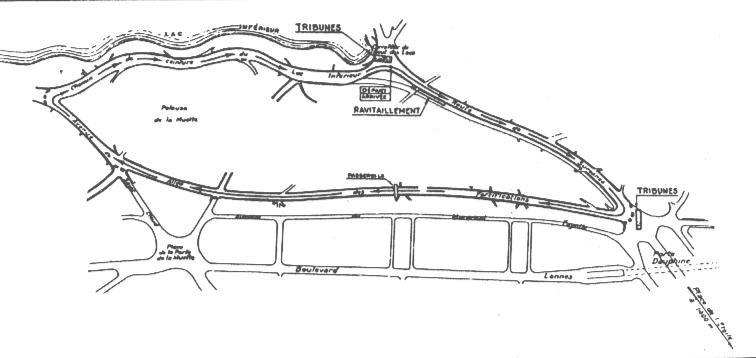
It has been a popular success: about 200,000 spectators. The first race, for 1500cc cars, was the Robert Benoist Cup in memory of the famous champion. He was virtual World champion in 1927 with his Delage and was a resistant during the war. He died in Buchenwald in 1944.
There were 17 entrants. Among them: Amédée Gordini at the wheel of the Simca 8 that he drove with José Scaron in Le Mans in 1939 to win the Index of Performance; Victor Polledry with an Aston Martin who also participated in the afternoon to the second race at the wheel of an Alfa Romeo 1750 SS; Jacques Savoye with his Singer, who was a famous importer of English cars in France since 1934 and winner of the 1100cm3 class in Le Mans in 1938.
The race was dominated from the first lap to the 36th and last lap by Amédée Gordini who also made the fastest lap. The winner received the cup from Robert Benoist’s daughter.
The second race, the Coupe de la Libération, was for supercharged 1500cc and unsupercharged 2000cc cars. There were 15 entrants, 6 Amilcar among them. Among the entrants we can mention Auguste Veuillet, who became importer of Porsche and founder of the Sonauto team later on; Roger Dého, the manufacturer of Fiat and Simca specials; Maurice Mestivier himself at the wheel of an Amilcar; René Bonnet, the co-founder of DB cars was also there at the wheel of his car; Marcel Balsa, Eugène Martin, Roger Loyer, Henri Louveau and Georges Grignard were there too. Henri Louveau (Maserati 6CM) won the race at the average speed of 99,8 km/h. He was 1 lap ahead of Auguste Veuillet (MG K3), 2 laps ahead of Lascaud (Amilcar G36) and 4 laps of ahead Ondet (Amilcar C0). He also made the fastest lap.
Then came the third race of the day: La Coupe des Prisonniers, surely the most famous. The minimum capacity of the engines was 3 liters. There were really good drivers and even top-class drivers: Wimille, Sommer, Etancelin, Chaboud, Grignard, Levegh, Gérard, Trintignant. Others were less known but it is worth mentioning some names: Paul Friderich (Bugatti 55), the son of Ernst Friderich - the Bugatti dealer in Nice who played a role at the beginning of Wimille’s career -; the Belgian Emile Cornet (Delahaye 135S), "attaché de presse" for the Princes of Monaco. There were 16 cars on the starting grid.
Most of the cars were the seven Delahayes 135S. There were also five Bugattis (a 59/50B for Wimille), one Talbot 150C (for Pierre Levegh), one Talbot T90MC (for Raymond Sommer), one Maserati 8CM (for Louis Gérard) and one Alfa Romeo 8C-2300 (for Phi-phi Etancelin).
Jean-Pierre Wimille was still a soldier at this time. Thanks to his friend François Sommer, Raymond’s brother, he was allowed by the French army to take part in the race... Unfortunately he arrived too late to participate in the practices and had to start the race at the back of the grid.
The poleman was Raymond Sommer at the wheel of an official Talbot T90MC “Centrale”. This was the second race in the history of this car. It started in the A.C.F GP in July 1939, driven by Mays, but it quickly dropped out. Its palmares has been satisfactory as it won the Comminges G.P. and the A.C.F GP in 1947, driven by Louis Chiron, and the Roussillon G.P. and the Marseille G.P., also in 1947, driven by Eugène Chaboud.
In fact the 43-laps-race was quickly run. At the Porte Dauphine hairpin, Wimille was 9th! After one lap he was 4th. After two laps Sommer was first in front of Wimille... who took the lead two laps later. Wimille, whose Bugatti was much more powerful (450hp) than the Talbot (250hp), was from 3” to 4” faster than Sommer. After signing the fastest lap in 1’25”2 he won the race 1’20” (nearly 1 lap) ahead of Raymond Sommer and ran the distance in 1h03’33”3 at the average of 114,7 km/h. The last place on the podium was taken by Eugène Chaboud (Delahaye) 3 laps behind. The fourth was Trillaud (Delahaye) at 4 laps, followed by Balsa (Bugatti) at 5 laps, Joseph Chotard (Delahaye) at 6 laps and Louis Villeneuve (Delahaye) at 9 laps.
Given the gaps it is obvious that there was a lack of homogeneity on the grid. But it is true that the Bugatti 59/50B was superior to the other cars, even if it did not show an exceptional pre-war palmares: it was uncompetitve in the international 750kg Formula. This car, with an 8-cylinder engine, only won the Paris Cup in Montlhéry in May 1939. The driver was of course Jean-Pierre Wimille and he was followed by Sommers’s Alfa Romeo…
After the Bois de Boulogne race Wimille told journalists: “I have not lost my touch. I was rather afraid after such a long period of inactivity, but after completing the first lap I knew: all would be as before. (…) the car was extraordinary! Bugatti has created an astonishing car. One in which, I think, I could win other races. (…) Yes the car was in perfect condition. I was very fortunate to drive it since one must not forget that it was Robert Benoist who concealed it from the Germans.”
The Coupe des Prisonniers was the very beginning of Wimille’s era which lasted until his death in January 1949. It was also the end of an era as it was the last victory of a Bugatti. Of course Ettore Bugatti did not know that but he was present with his own Bugatti Royale to witness the victory of his car and his driver.
However the most important was not the result of the race but the symbol: “The impression given by this event has been considerable. Each spectator understood that the moral winner of the day was the country itself,” as Charles Faroux, the great journalist, wrote.
This Coupe des prisonniers is also well-known because it was during this meeting that Maurice Trintignant was given the nickname “Pétoulet” by Jean-Pierre Wimille. Indeed Maurice Trintignant had to give up because of drop rats (Pétoules in Provençal) in the carburator of his Bugatti 35C/51. When he told Wimille, Veyron and Roland Bugatti (Ettore’s son) the reason of his retirement, the three guys laughed and the winner of the day told him: “Now we’ll call you Pétoulet!”
Other races occured in the Bois de Boulogne in 1946, 1947 and 1951. But the security of the spectators and the drivers was not assured. Thus it has been decided to stop the organization of such races which looked like fairs instead of true races.
But the strong link of the Bois de Boulogne with motor racing still exists. Since 1988, the French magazine Automobiles Classiques and the Louis Vuitton company have been organizing, every first weekend of september, a concours d’élégance in the Bagatelle park, which is in the Bois de Boulogne. Every year, the most beautiful cars of history are there to allow a jury to select the “best of show”. This great event, now considered as the French Pebble Beach, perpetuates the importance of the Bois de Boulogne in the automobile heritage.

